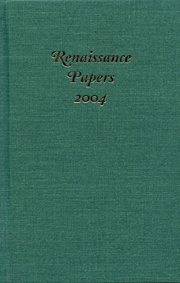Book contents
- Frontmatter
- Contents
- Renaissance Papers
- All Ovids Elegies, the Amores, and the Allusive Close of Marlowe's Hero and Leander
- Revisiting Shakespeare's Eliot
- “'Tis Rigor and Not Law”: Trials of Women as Trials of Patriarchy in The Winter's Tale
- Crossing Wits: Donne, Herbert, and Sacramental Rhetoric
- Love and Power: The Rhetorical Motives of John Donne's 1622 Sermon to the Virginia Company
- Crashaw, Catholicism, and Englishness: Defining Religious Identity
- Addendum
- Beyond “no end”: The Shape of Paradise Lost X
Revisiting Shakespeare's Eliot
Published online by Cambridge University Press: 12 September 2012
- Frontmatter
- Contents
- Renaissance Papers
- All Ovids Elegies, the Amores, and the Allusive Close of Marlowe's Hero and Leander
- Revisiting Shakespeare's Eliot
- “'Tis Rigor and Not Law”: Trials of Women as Trials of Patriarchy in The Winter's Tale
- Crossing Wits: Donne, Herbert, and Sacramental Rhetoric
- Love and Power: The Rhetorical Motives of John Donne's 1622 Sermon to the Virginia Company
- Crashaw, Catholicism, and Englishness: Defining Religious Identity
- Addendum
- Beyond “no end”: The Shape of Paradise Lost X
Summary
Now that my 1986 suggested validation of Lewis Theobald's 1726 conjectural “'a babbled of green fields” is becoming accepted, it seems appropriate to ask what difference the discovery might make, assuming it stands, beyond discouraging further briefs for and against the F reading. Here below then I address questions Stuart Gillespie, “John Eliot,” in Shakespeare's Books, begs when he attributes the Theobald emendation to “enduring, though inconsequential, memories of- ten created … in the course of language-learning” (137), and subsumes it among “apparent echoes in several other plays, notably Histories, mostly at the level of phraseology and usually of little further significance” (137-38). Finally in conclusion I consider how developing technology might enable and accelerate discoveries of other such echoes.
In writing HV Shakespeare consulted John Eliot's Ortho-epia Gallica (London: 1593), a French language manual for English-speakers consisting primarily of dialogues in French and their English translations. In the earlier parts of the manual, the corresponding dialogues occupy the same page in separate columns, sometimes separated by a third column of rough “phonetic” spelling of the French. In the final section, “Second Method” (i1v -y4), the French occupies verso pages, with the English on facing rectos. Work with Romeo and Juliet led me, via Lever, “French Fruits,” to the Eliot, where residual investment from earlier work with H5 must have drawn my attention to the col- location of “Babillards” and “greene fields” in Eliot's final dialogue, “The Conclusion of the Parlement of Pratlers.”
- Type
- Chapter
- Information
- Renaissance Papers 2004 , pp. 17 - 28Publisher: Boydell & BrewerPrint publication year: 2005



